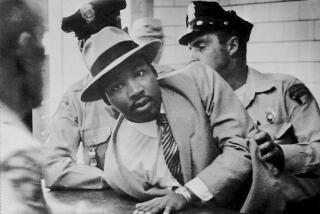Reza Aslan talks ‘Zealot,’ the book behind the viral Fox News video
Having spoken earlier to author Reza Aslan about his viral video with a certain Fox News reporter, The Times took a few moments Tuesday to talk to the UC Riverside professor about his book and what’s in it.
“Zealot: The Life and Times of Jesus of Nazareth” (Random House, $27) is a lucid, intelligent page turner about “the historical Jesus.” It’s a portrait of the violent and changing times he lived in and the decades that preceeded the ill-fated rebellion of the Jews against the Roman Empire and the destruction of Jerusalem.
You say early in your book that your study of Jesus’ life has made you “a more genuinely committed disciple of Jesus of Nazareth than I ever was of Jesus Christ.” What exactly do you mean by that?
Millions of Christians in the world think that Jesus is fully God and fully man…. But for me, the more I studied the earthly Jesus and the world in which he lived, the powers that he confronted and the social ills that he addressed, the more real he became. He was far more real than the celestial Christ I had been introduced to in my church.
In a sense I wanted to have, as Evangelicals put it, a personal relationship with Jesus of Nazareth. To me that was far more meaningful than the relationship that I’d had with the Christ. For many Christians … all of his actions and all of his suffering are put into the framework of his knowledge as an eternal being — everything he does is all for some greater spiritual good. To me that’s less compelling than an actual human being who sacrifices himself on behalf of the dispossessed and the outcast.
I can see in “Zealot” the influence of the sociology you’ve studied — in the sense that you try to reconstruct the social relationships and the larger context of the beliefs of the society Jesus was living in.
What’s amazing about the world that Jesus lived is that it’s a world that we know a lot about. First-century Palestine, thanks to Roman occupation, was a very well documented society. We know a great deal about the social, political and religious context of Jesus’ times. That’s important because we know very little, almost nothing, about Jesus himself outside of the Gospels. It’s up to the historian to fill in the holes left behind by gathering what information we can from his time and place. In the case of Jesus, the picture that arises bears very little resemblance to the catechistic creature of good works most Christians are familiar with.
The portrait that emerges of Jesus in your book is of a rebel, a “zealot.” He is a man who is shaped by the great movements of the day and especially the resistance to the Roman presence.
We’re talking about an illiterate, uneducated poor peasant from the Galilean countryside whose charisma was so great and whose teachings were so compelling that he gathered a mass of followers and marched with them into the lion’s den, into the seat of the Roman presence in Judea and also into the heart of Jewish culture, the Temple. And in the name of the outcasts, the marginalized and dispossessed people … he took on the greatest empire the world had ever know and sacrificed himself for it. How can that person not be worth knowing? This is a man who is heroic in very sense of the world. He’s the quintessential Hollywood action hero.
“Zealot” has some wonderful novelistic touches, moments when you work hard to visually fill out the scenes while recounting various episodes of Jesus’ life. If you could put yourself in a time machine and witness one of the moments in your book, which one would it be?
The most pivotal moment of Jesus’ brief ministry was the so-called cleansing of the Temple. It was the event that led to his arrest and execution. Jesus and his multitude of followers triumphantly entered Jerusalem and the Temple marketplace … and violently attacked it, which is how the events are described in the Gospels. He and his followers are breaking open the cages that hold the animals, they’re kicking over the tables of the moneylenders and the money changers. The Gospels say that he makes a whip out of cords and starts beating people.
That kind of violent zealotry is the lens through which we need to see Jesus. That’s the single most important moment in trying to understand what his relationship was to Judaism and the Jewish authorities at the time and why he was seen as such a threat to the Establishment. I would have loved to have been there to see that.
ALSO:
Reza Aslan’s Jesus book a No. 1 bestseller
Are Amazon’s new book discounts a ‘declaration of war’?
Obama appearance at Amazon warehouse angers booksellers
More to Read
Sign up for our Book Club newsletter
Get the latest news, events and more from the Los Angeles Times Book Club, and help us get L.A. reading and talking.
You may occasionally receive promotional content from the Los Angeles Times.







